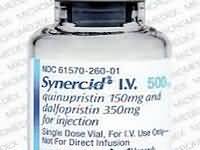CLINICAL USE
Antibacterial agent
DOSE IN NORMAL RENAL FUNCTION
7.5 mg/kg every 8 hours
PHARMACOKINETICS
DOSE IN RENAL IMPAIRMENT
GFR (mL/MIN)
DOSE IN PATIENTS UNDERGOING RENAL REPLACEMENT THERAPIES
IMPORTANT DRUG INTERACTIONS
Potentially hazardous interactions with other drugs
ADMINISTRATION
Reconstition
With 5 mL glucose 5% or water for injection
Route
IV infusion
through a central line
Rate of Administration
Over 60 minutes
Comments
Central access is recommended: Dilute reconstituted solution further in —100 mL glucose 5% for central access Or 250 mL for peripheral access (for —emergency administration of 1st dose only). Stable for 5 hours at room temperature and 24 hours if refrigeratedIncompatible with saline solutions
OTHER INFORMATION
After the infusion, flush the line with glucose 5% to minimise venous irritationHas been administered intraperitoneally at a dose of 25 mg/L in alternate bags, in combination with intravenous treatmentSynercid is an inhibitor of CYP 3A4: caution is recommended when co-administering any drug also metabolised by this route
